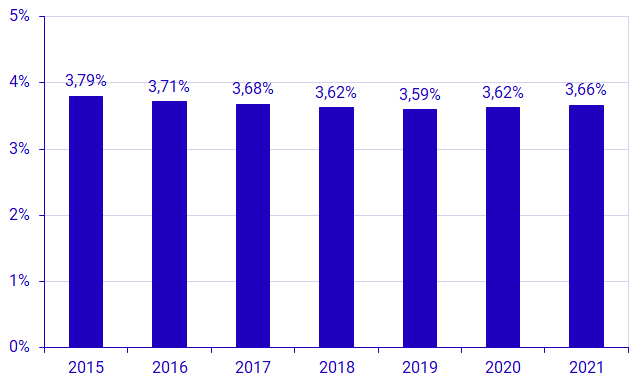Government budget allocations for R&D (GBARD) 2021
R&D funding to universities increased in 2021
Statistical news from Statistics Sweden 2021-04-21 9.30
For 2021, funds for research and development (R&D) in the central government budget are estimated at SEK 42.7 billion, which is an increase of SEK 3.6 billion, calculated at the 2021 price level. A majority of the research funding, 50 percent, will go to universities and colleges, which is SEK 1.4 billion more than in 2020.
The Government Bill 2020/21:1 Budget Bill for 2021 shows that public budget appropriations for R&D are estimated to increase by SEK 3.6 billion compared with the forecast for 2020, calculated at the 2021 price level. R&D appropriations correspond to 3.7 percent of total appropriations and 0.8 percent of GDP. The proportion of R&D funds in the central government budget has remained largely unchanged since 2015.

The central government budget is grouped into 27 expenditure areas, each representing a part of the economy. The expenditure areas that have been allocated the most R&D funds are Education and academic research, Industry and trade and General environmental protection and nature conservation.
Breakdown of socioeconomic objective based on updated classification
This year, the breakdown is based on the NABS 2007 classification, the Nomenclature for the analysis and comparison of scientific programs and budgets. NABS 2007 is used internationally and enables simpler comparisons with other member countries in the EU and OECD. The previous breakdown was based on NABS 1993; although it was more detailed and adapted to the needs of the Nordic countries.
The socioeconomic objective General advancement of knowledge: R&D financed from General University Funds (GUF) was allocated the most R&D funding, at SEK 21 billion, which corresponds to 50 percent of total R&D appropriations. This means an increase of about SEK 1.4 billion compared with the autumn budget for 2020.
The objective General advancement of knowledge: R&D financed from other sources than GUF increased the most compared with last year’s forecast, by an estimated increase of about SEK 1.5 billion at the 2021 price level.
| Socioeconomic objectives (NABS 2007) | 2020 | 2021 |
|---|---|---|
| NABS01 - Exploration and exploitation of the earth | 478 | 788 |
| NABS02 - Environment | 692 | 985 |
| NABS03 - Exploration and exploitation of space | 422 | 338 |
| NABS04 - Transport, telecommunication and other infrastructures | 1 780 | 2 283 |
| NABS05 – Energy | 1 738 | 1 600 |
| NABS06 - Industrial production and technology | 1 683 | 996 |
| NABS07 - Health | 879 | 1 052 |
| NABS08 – Agriculture | 523 | 808 |
| NABS09 - Education | 204 | 271 |
| NABS10 - Culture, recreation, religion and mass media | 70 | 51 |
| NABS11 - Political and social systems, structures and processes | 993 | 1 063 |
| NABS12 - General advancement of knowledge: R&D financed from General University Funds (GUF) | 19 758 | 21 190 |
| NABS13 - General advancement of knowledge: R&D financed from other sources than GUF | 8 836 | 10 329 |
| NABS14 – Defence | 983 | 938 |
| Total R&D appropriations | 39 040 | 42 692 |
Facts
The forecast is based on the provisional budget of 2021.
The “Government budget allocations for R&D” survey, on which these statistics are based, highlights how much of the central government budget is used to fund R&D. Unlike regular surveys on R&D activities in various sectors of society carried out every two years by Statistics Sweden, this survey provides an up-to-date forecast of central government appropriations for R&D for the current year.
The survey follows guidelines prepared by the OECD and published in the Frascati Manual – Guidelines for Collecting and Reporting Data on Research and Experimental Development (OECD, 2015). These statistics are also subject to the Commission Implementing Regulation (EU) No 2020/1197 of 30 July 2020. The data is submitted to Eurostat, which produces compilations for the EU countries.
A presentation of the survey results also includes a forecast of R&D disbursements by public research foundations. These funds are presented separately and are not included in the report on total R&D funds in the central government budget.
NABS 2007
NABS is a functional classification for the analysis of public financing of research and development (R&D) on the basis of the socio-economic objectives pursued by the central governments or stated by them in drafting their budgets and programmes. It is linked to the Frascati Manual (OECD).
Fixed price calculation
This statistical news includes comparisons over time concerning government funding to R&D. All comparisons are based on fixed-price calculated price levels for 2021. Fixed price calculation is an approach used to restate (adjust for inflation) price levels and to clear any price effects that may impact expenditure levels. Fixed price calculation applies GDP deflators according to:
Deflator = (Nominal GDP)/(Real GDP)×100
Definitions and explanations
Research and experimental development (R&D) comprise creative and systematic work undertaken in order to increase the stock of knowledge – including knowledge of humankind, culture and society – and to devise new applications of available knowledge.
For an activity to be an R&D activity, it must satisfy five core criteria. The activity must be:
- Novel
- Creative
- Uncertain
- Systematic; and
- Transferable and/or reproducible
Next publishing will be
The next statistical news in this series will be published in April 2022.
Feel free to use the facts from this statistical news but remember to state Source: Statistics Sweden.
